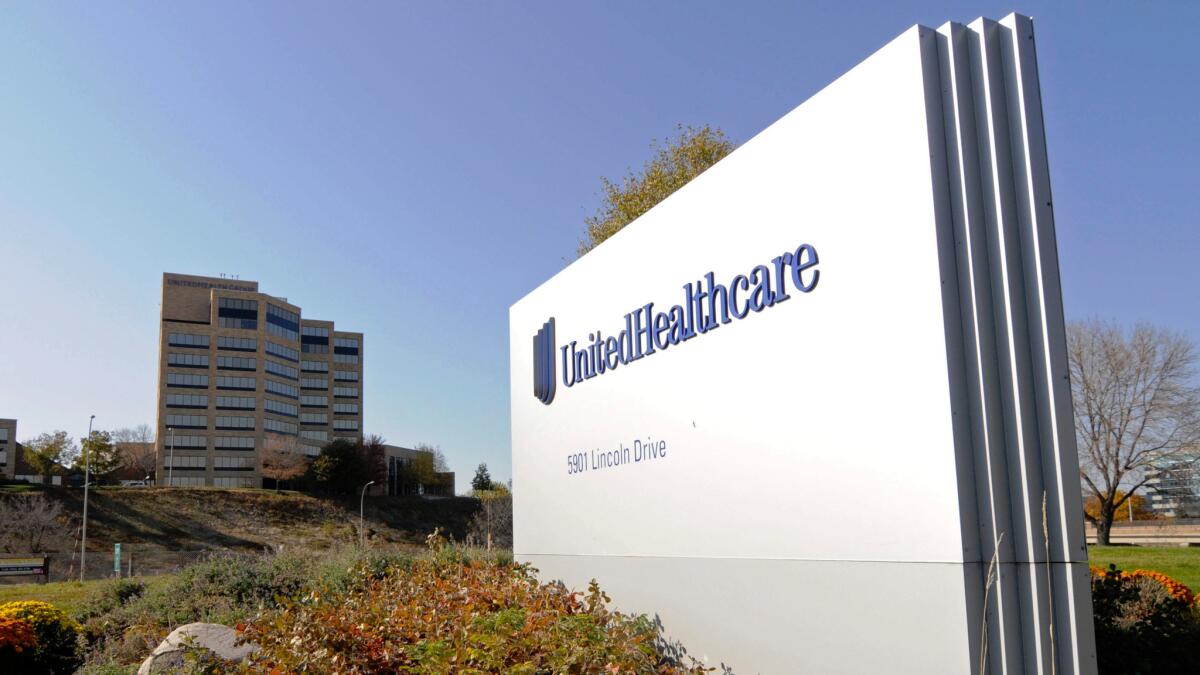Column: UnitedHealth’s profits show it’s great to be an insurer during a pandemic

Americans are protecting themselves from the COVID-19 pandemic in part by staying home and forgoing routine medical exams and other forms of non-urgent healthcare.
Yet the country’s largest commercial health insurer, UnitedHealth Group, on Wednesday reported a better-than-expected $3.2 billion in quarterly profit.
And it reaped this windfall despite offering what it called “extensive” financial assistance for some policyholders in the form of reduced rates and co-pays.
All of which raises an important question: How much profit is enough when it comes to health insurance?
Or, put another way, should we just hold our noses as health insurers rack up huge profits because, well, that’s capitalism for you?
“One of the core principles of economics is that firms are profit-maximizing — they will set their prices in a way that maximizes profit,” said Aparna Soni, an assistant professor of public administration and policy at American University.
“While one may argue that health insurance companies have a moral obligation to provide insurance at affordable prices,” she told me, “at the end of the day, the objective of any private firm is to maximize profits.”
She’s right, of course. But count me among those who believe selling health insurance isn’t like selling widgets.
People’s lives are literally on the line, and many Americans can find themselves financially wiped out by a serious illness.
UnitedHealth is aware of the optics of raking in huge amounts of cash during a global pandemic.
The company’s executives emphasized during an earnings call Wednesday that financial assistance to consumers and business partners resulted in a drop in quarterly net income from a year earlier.
Yet if the company could still pull down more than $1 billion a month in profit, what does that say about its normal, nondiscounted rates?
Not one healthcare expert I spoke with said this is evidence of price gouging, observing that there are too many variables when it comes to healthcare pricing to know if consumers are being unfairly taken advantage of.
But most said it’s fair to wonder if rates charged by health insurers accurately reflect their cost of doing business.
Douglas Barthold, an assistant professor in the University of Washington’s School of Pharmacy, said it’s “probable” that health insurers charge too much in premiums and co-pays relative to their expenses.
But he said UnitedHealth’s profit margin “isn’t necessarily conclusive” in this regard.
“Perhaps if utilization had stayed at pre-pandemic levels, they would have lost money,” Barthold observed.
That appears doubtful. Healthcare activity in the third quarter was about 95% of normal, according to UnitedHealth’s own estimates.
That means we’re darn close to pre-pandemic levels of healthcare utilization. And UnitedHealth, even after cutting rates for policyholders, was still earning big bucks.
The third-quarter numbers reflect the gradual loosening of lockdown restrictions that took place over the last three months. More people filed insurance claims as they once again started seeing their doctor.
In the second quarter, when the lockdown was more pervasive, Minnesota-based UnitedHealth’s earnings doubled to $6.6 billion thanks to a steep plunge in claims while the company continued pocketing customer premiums.
The key metric here is what’s known as the medical cost ratio — how much an insurer pays out in claims relative to its income from premiums.
This is also known as the medical loss ratio because the industry views paying claims as a financial setback, which tells you everything you need to know about how you’re perceived as a customer.
Under the Affordable Care Act, larger health plans must have a medical cost ratio of 85%, meaning that 85% of premium income goes to paying claims. Smaller plans can have a ratio of 80%.
In the most recent quarter, UnitedHealth’s medical cost ratio was 81.9%, compared with 82.4% a year earlier.
In the second quarter, the company’s medical cost ratio plummeted to 70.2% as consumers stayed as far as they could from hospitals and doctor’s offices.
The pandemic, in other words, has been great for health insurers.
Profits soared during the spring and summer thanks to reduced claims. And they’re rising now thanks to seemingly higher-than-needed co-pays and premiums.
UnitedHealth’s profit for the year through Sept. 30 reached $13.2 billion, a whopping 28% increase from $10.3 billion for the same period last year.
Eric Hausman, a UnitedHealth spokesman, told me the company recognized earlier in the pandemic that it would have to “correct any financial imbalances” that occurred as a result of people filing far fewer claims while continuing to pay the same premiums.
Thus it devoted about $1.5 billion to rate and co-pay relief to policyholders, he said.
And that’s fine. But if UnitedHealth could still pocket more than $1 billion a month in profit, even with those discounts, doesn’t that mean its normal rates are too high?
Hausman declined to answer that question. Instead, he reiterated that the company strives “to develop solutions to help make the healthcare system work better,” such as a recent program to assist people with Type 2 diabetes.
In light of its most recent quarterly results, UnitedHealth has raised its profit outlook for the year.
Melissa Thomasson, a healthcare economist at Miami University, said this “probably isn’t price gouging” because “premiums are typically set in advance based on what an insurer thinks claims will be.”
Thus, UnitedHealth and other insurers set rates prior to the pandemic and are just the happy recipients of gobs of cash resulting from fewer claims being filed.
“I see this as a case where insurance companies may have been handed a windfall, as money in was based on a high projection of money out, and money out ended up low,” said Andrew Friedson, an associate professor of economics at the University of Colorado Denver.
Many studies show that people’s out-of-pocket insurance costs would be reduced if current premiums, deductibles and co-pays were replaced by a tax for a “Medicare for all” system.
Studies also show that coverage becomes significantly less costly to provide when the efficiencies and economies of scale of a single payer — Medicare — replace the bureaucracies and self-interest of dozens of for-profit insurance providers.
From a shareholder perspective, it’s great that UnitedHealth and other insurers are doing so well amid the nation’s hardship.
From a public policy perspective, I wonder how long a country that spends more than $3.5 trillion a year on healthcare — more per capita than any other developed country — wants to remain on this path.
When is enough enough?
More to Read
Inside the business of entertainment
The Wide Shot brings you news, analysis and insights on everything from streaming wars to production — and what it all means for the future.
You may occasionally receive promotional content from the Los Angeles Times.










